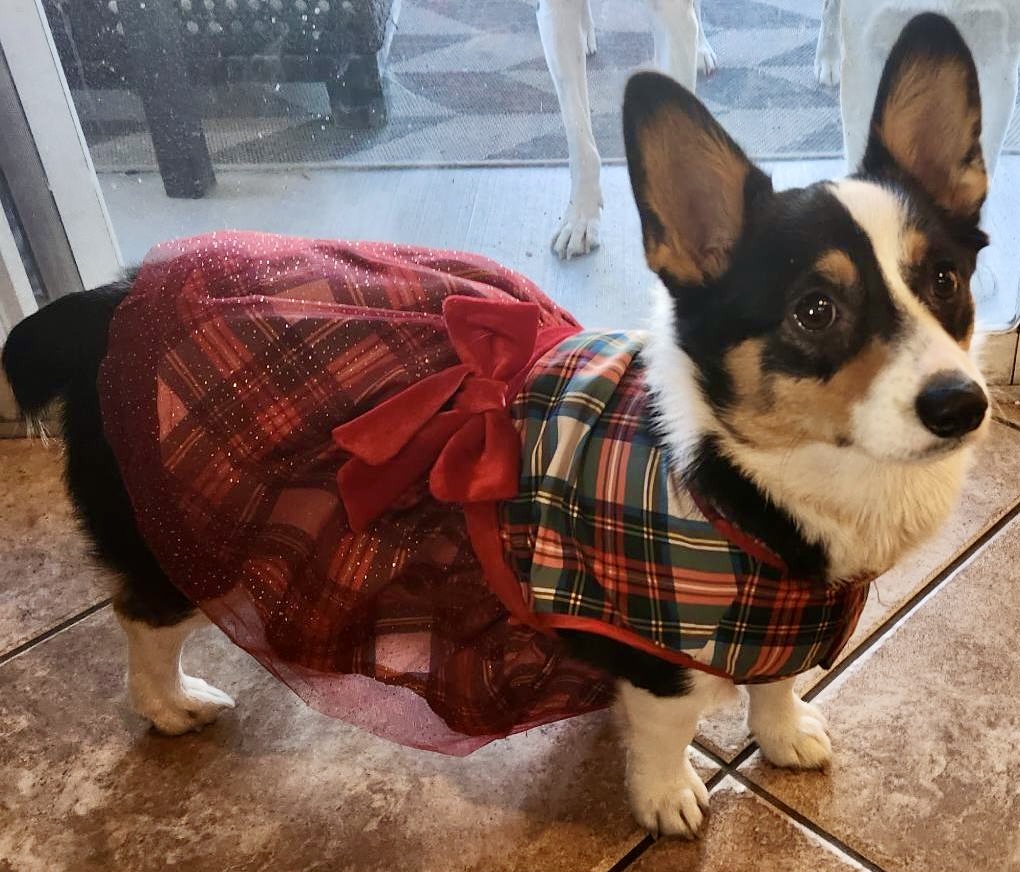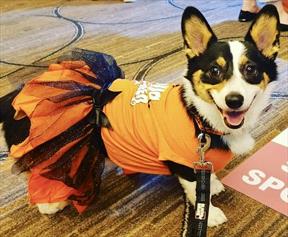Penny in tartan

Photo by Stephanie Duval
Penny has an extensive wardrobe for whatever the outing, whether a walk in the park or going out on the town in Las Vegas.
Penny, a 1-year-old Pembroke Welsh corgi, has an orange tutu with jet-black highlights in a lavish wardrobe that also features a close-fitting tartan dress and matching sheer overlay rendered in burgundy red.
Her owner, Stephanie Duval, prefers to give Penny a feminine look, whether she's taking her to the park or bringing her along to a restaurant.
Duval, a resident of Las Vegas, keeps some practicalities in mind. She leaves room for Penny to take care of toileting, and always has a collar at hand — though while bringing some joie de vivre to even that most pedestrian item of dog attire.
"She has more collars, I think, than I have jewelry," Duval said in an interview.
Penny is just one of a growing number of pets that, despite possessing their own natural fur coats, are finding themselves draped in clothing like what humans wear.
The fashion craze raises questions about its underlying drivers and durability, while stoking discussion in the veterinary community about the purported health benefits — and myriad hazards — of dressing pets as people.
Data released by market research firms indicates that growth in the pet fashion sector has been profound and may be sustained at a decent clip for years to come. The amount spent globally on pet fashion has jumped 21% since 2019, with the average yearly amount spent per owner rising 9% to $68, according to a report released December by the market research firm SkyQuest. The firm expects the total spend to grow by more than 5% a year to 2028 at least, as does another market research firm, Emergen Research.
Plenty of reasons are offered for such solid growth, including humans' desire to shield animals increasingly regarded as family members from the elements; a tendency to anthropomorphize (attribute human experience to non-human animals); or a simple penchant for fun. More broadly, demand for any product or service associated with pets— from food to veterinary care — was boosted during the Covid-19 pandemic after lockdowns triggered a boom in pet ownership.
For Duval, buying clothes fulfills part of her nurturing need. "As a woman almost in her 40s, I never had kids," Duval said. "I don't know. She just became my baby."
Interest in pet fashion is even sprouting among veterinary students, according to Dr. Tony Bartels, a student debt consultant for the Veterinary Information Network, an online community for the profession and parent of the VIN News Service. Bartels said students budgeting their expenses often include a line item for pets. "Over the years, I have gotten asked more about if pet accessories, like clothing, would go in that category, as well," he said.
Protection from the elements?
Dogs, followed by cats, are most exposed to the fashion trend, accounting for 60% and 30%, respectively, of clothing sales, according to the SkyQuest research. The remaining 10% is bought for animals such as rabbits, guinea pigs and ferrets.
Coats and jackets are most popular, though plenty of other products are on the market, such as T-shirts, trousers, leggings and dresses, along with accessories such as hats, shoes and sunglasses. The likes of Gucci and Hugo Boss have released luxury pet-fashion ranges (a Gucci dog coat is listed online at $930), and have started displaying them on catwalks. Lower-end retailers, such as H&M, are getting in on the act, too.
Although retailers' ultimate end users typically are equipped to deal with the elements by virtue of their fur, some breeds may appreciate a Hugo Boss "dog bomber jacket" (listed price: $270) more than others.
At the obvious extreme, hairless breeds, such as the Chinese crested dog and xoloitzcuintli, are more vulnerable to the elements, such as the sun's ultraviolet rays, said Dr. Ramon Almela, a veterinary dermatologist at the Tufts University Cummings School of Veterinary Medicine. So it wouldn't hurt, he said, to cover them up during extreme cold weather and wrap their body with a light layer of cloth during peak hot weather.
By contrast, Nordic breeds with thick fur, such as the Alaskan malamute, don't need sweaters, even in extreme cold, Almela said.
In general, common short-haired breeds such as Labrador retrievers will not need clothing, as long as the dog is active and the temperature is not extremely cold, said Dr. Sagi Denenberg, a veterinary behaviorist based in Toronto. Still, he said a Labrador might fare better in extreme cold than leaner breeds such as greyhounds and whippets, which get very little insulation from body fat.
"Age and health play a role in the body's ability to maintain core temperature, and also activity," Denenberg, added. "Young adults that are active may not need clothing, while senior dogs with minimal body fat and that are inactive may need it."
Size also matters, according to Dr. Carlo Siracusa, a veterinary behaviorist at the University of Pennsylvania. That's because small animals have a larger body surface area (the amount of skin in proportion to body mass) and therefore lose body heat faster than large dogs.
Consequently, puppies and small dogs with thin or sparse body hair, such as Chihuahuas and short-haired terrier breeds, may benefit most from clothing, especially in the winter months and/or in colder geographic locations.
Apart from perhaps offering protection from the weather, a curious quirk of clothes is that they might help dogs manage anxiety. Applying pressure, Siracusa maintains, can have a calming effect on animals.
One product on the market, ThunderShirt, a cloth-wrap fastened by Velcro, can calm dogs during stressful situations that might include exposure to fireworks, thunderstorms and visits to the veterinarian, its manufacturer claims. Apparently, the company says, pressure applied to a dog's torso has a relaxing effect akin to swaddling a baby.
Research supports the idea that ThunderShirts can calm dogs with anxiety disorders by slowing a pounding heart rate. A study published in 2014 found that dogs wearing tightly-fitted shirts had a significantly lower heart rate that dogs wearing loosely fitting shirts or no shirt at all.
Pitfalls of clothing are many, practitioners say
Still, veterinarians caution that pet owners need be aware of the line between the benefits of clothes, and the various pitfalls associated with them — both physical and psychological.
Just as coats can protect some pets from the cold, they also can cause overheating in the large number of pets that don't need them. Generally, overheating can affect breathing and blood pressure, especially in brachycephalic (flat-faced) breeds such as bulldogs and pugs, said Denenberg.
"This would be more obvious and dangerous (I believe) in brachycephalic breeds, especially those with brachycephalic obstructive airway syndrome," he added. Nevertheless, Denenberg said clothing might not necessarily lead to overheating, depending on the circumstances. "I doubt that a normal walk in extremely cold weather, wearing a coat, would lead to hyperthermia," he said.
Skin problems, too, can arise. Tight clothes can decrease ventilation and increase humidity, which predisposes dogs to skin diseases and infections, said Almela. However, putting on a coat for a short walk should not cause any serious problems, he said.
Problems associated with clothing are far from just skin deep. Dressing up pets can cause them all sorts of mental torment that may even trigger aggression toward owners, animal-behavior experts warn.
Dressing a pet when it's cold is not the same as dressing it for Halloween, said Siracusa, who warns that clothes could inhibit an animal's movement, if not freak it out entirely.
"First of all, a lot of these costumes are big and heavy and scary," Siracusa said, adding that some dogs might freeze, not knowing what to do.
Penny in halloween dress

Photo by Stephanie Duval
Penny wasn't thrilled when she was first clothed, but her owner says the corgi has gotten accustomed to being dressed and even seems to enjoy it now.
Moreover, Siracusa said that since dogs communicate with each other through body language, sounds and smells, anything that impedes their bodily functions could be a great source of angst. The way dogs fold and flip their ears, for example, can indicate whether they are focused or aggressive — potentially making headwear especially problematic.
Dogs also might display a reflex behavior called piloerection, whereby their hairs stand upright due to a host of emotional triggers. Research indicates that the dense fur of some dog breeds naturally may obscure signals like piloerection, impeding communication. Dressing dogs up would similarly obscure that important visual cue.
"Anything that interferes with this makes a disservice to the dog. It may make them feel uncomfortable and more vulnerable to other dogs," Siracusa said.
Further, small animals dolled up to appear funny and cute could attract attention from strangers — and many pets get scared when unfamiliar people approach them, according to Siracusa.
Any changes in a pet's temperament could end up creating trouble for humans, said Denenberg. While it cannot be generalized, "dressing up dogs can actually lead to aggression toward owners," he said, as clothes cover their body parts, changing the way they look to other dogs and making them feel edgy in general. "Dogs don't choose [what] to wear; they don't go to the shop and buy it. They just tolerate it," he said.
Likewise, Siracusa said dogs do not enjoy being dressed, although they may put up with clothes in certain circumstances. He said people are not very good at perceiving subtle signs of stress in dogs and may mistake the signs as something cute or endearing.
For example, certain behaviors like yawning, lip licking, and panting could be early signs of distress, noted Siracusa. "Only when a dog tries to bite will they be worried. But if a dog says something politely using a fear body language, it gets really missed."
Making dogs wear boots could fuel aggression sometimes, too, Denenberg noted, since dogs generally dislike their sensitive paws being touched. When roads are frosty or salted, Denenberg looks for a suitable place for his own dog to walk with open paws. If no such route exists, Denenberg accepts that boots may be appropriate. "That is not to say the dog likes it or understands why the owner insists on placing boots," he said.
Siracusa acknowledges that some individual animals, if they don't appear to be distressed, even subtly, and enjoy interacting with people, could be fine in a costume. Even then, he notes the apparel may influence their interaction with other animals.
For her part, Duval noticed that Penny looked a little bit annoyed when she first clothed her. "But once it's on her, it doesn't bother her at all," she said. In fact, Duval believes that Penny has, over time, come to enjoy being dressed. "She really likes that orange one. That's her Halloween dress. I think she felt cool in it."